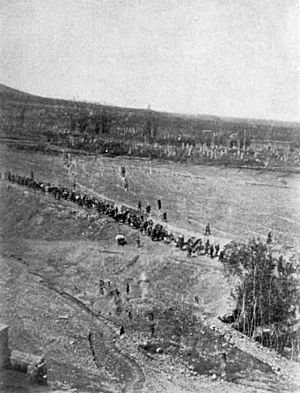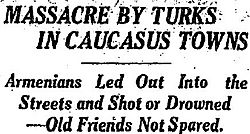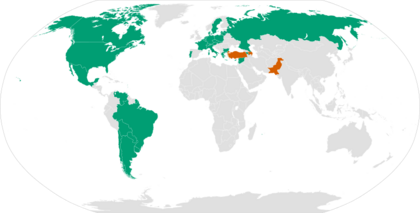Armenian genocide facts for kids
Quick facts for kids Armenian Genocide |
|
|---|---|
| Part of World War I | |

Column of Armenian deportees guarded by gendarmes in Harput Vilayet
|
|
| Location | Ottoman Empire |
| Date | 1915–1917 |
| Target | Ottoman Armenians |
|
Attack type
|
Genocide, death march, forced Islamization |
| Deaths | 600,000–1.5 million |
| Perpetrators | Committee of Union and Progress |
| Trials | Ottoman Special Military Tribunal |
The Armenian genocide was a terrible event where many Armenians were forced to leave their homes, killed, or made to change their religion. This happened from 1915 to 1917 in the Ottoman Empire, which was ruled by a group called the Young Turks.
Contents
Why it happened
In November 1914, the Ottoman Empire joined World War I. They fought alongside the Central Powers. The War Minister, Enver Pasha, led a military attack against Russia in the Caucasus region. He hoped to capture a city called Baku. But his army lost badly at the Battle of Sarikamis, and many soldiers died from the cold.
When Enver Pasha returned, he largely blamed the Armenians in the area. He said they helped the Russians. Even though there were some problems, Armenians had generally done well under Ottoman rule. Many Armenians were better educated and wealthier than their Turkish neighbors. This made some Turks feel jealous. People also worried that Christian Armenians would support other Christian countries, especially Russia, which shared a border with the Ottoman Empire.
In 1914, the Ottoman War Office started spreading ideas that Armenians were a danger to the empire. An officer described how they planned this:
In order to justify this enormous crime the requisite propaganda material was thoroughly prepared in Istanbul. [It included such statements as] "the Armenians are in league with the enemy. They will launch an uprising in Istanbul, kill off the Ittihadist leaders and will succeed in opening the straits [of the Dardanelles]."
The Ottoman government acted quickly. On April 24, 1915, they arrested about 250 Armenian thinkers and leaders. The attacks against Armenians continued for several years. By 1922, only about 388,000 Armenians remained. Armenians still remembered earlier attacks from 1894, 1895, 1896, and 1909.
What happened to Armenians
In 1915 and 1916, Armenians were forced out of their homes. Turks then took over these homes. During a campaign to make everyone more Turkish, government groups took Armenian children. They changed the children's religion and gave them to Turkish families. In some places, women were forced into difficult situations or made to work without pay. Some women would hurt themselves to avoid these situations. Muslim families moved into the homes of Armenians who had been forced out and took their belongings.
The Turks also created a group called the Special Organization (Teşkilât-ı Mahsusa). This group formed special teams to carry out killings. These teams were often made up of criminals.
Henry Morgenthau, who was the American ambassador to the Ottoman Empire, wrote in 1919: "I am confident that the whole history of the human race contains no such horrible episode as this. The great massacres and persecutions of the past seem almost insignificant when compared with the sufferings of the Armenian race in 1915."
Why some deny it
Guenter Lewy wrote a book called The Armenian Massacres in Ottoman Turkey: A Disputed Genocide. He claims there isn't enough proof that the Young Turks government planned the killings of Armenians. Lewy believes that even though Armenians suffered greatly during World War I, it wasn't a "real" genocide. He says there was no central plan by the government to destroy the Armenian people.
A big reason why the genocide is not widely recognized is the official view of Turkey. Turkey says there was no plan to wipe out the Armenian population. They state that the 1915 killings happened because of a deportation law and the war. In December 2008, some Turkish scholars started an online petition. People could apologize for what happened. However, those who made the petition did not use the word "genocide." Instead, they used "Great Catastrophe." Many Turks saw Armenians as a threat during wartime. They also argued that people from many different groups were killed during the violence. Turkey and its leaders worry that recognizing the word "genocide" could lead to large payments and public shame.
Countries that recognize it
Because Turkey continues to deny the genocide, many Armenian groups around the world have worked hard for international recognition. This has become a very important goal for Armenians living outside their homeland. From the 1970s onwards, many countries avoided recognizing the genocide to keep good relations with Turkey. As of 2023[update], 31 UN member states have officially recognized the genocide. Pope Francis and the European Parliament have also recognized it. Azerbaijan, Pakistan, and Turkey openly deny the genocide.
How it's shown in culture
After meeting Armenian survivors, an Austrian-Jewish writer named Franz Werfel wrote a book. It was called The Forty Days of Musa Dagh. This book was a fictional story about a successful Armenian uprising. It was also a warning about the dangers of Nazism. The book came out in 1933. It is seen as one of the most important books of the 20th century about genocide. It is still a very important book for Armenians everywhere. The genocide also became a main topic in English-language Armenian-American literature.
The first movie about the Armenian genocide was Ravished Armenia. It was released in 1919 to raise money for Near East Relief. The movie was based on the true survival story of Aurora Mardiganian, who played herself in the film. Since then, more movies about the genocide have been made. However, it took many years for them to reach a large audience. The paintings of Arshile Gorky, an abstract expressionist artist, were shaped by his experience of the genocide. More than 200 memorials have been built in 32 countries to remember this event.
Records and history
The genocide is well-documented in official records from Germany, Austria, the United States, Russia, France, and the United Kingdom. It is also documented in the Ottoman archives, even though Turkey has removed some documents. There are also thousands of stories from eyewitnesses. These include Western missionaries and Armenian survivors.
A Polish-Jewish lawyer named Raphael Lemkin created the word genocide in 1944. He became interested in war crimes after reading about the 1921 trial of Soghomon Tehlirian. This trial was for the killing of Talaat Pasha. Lemkin saw what happened to the Armenians as one of the most important genocides of the 20th century. Almost all historians and experts outside Turkey, and a growing number of Turkish experts, agree that the destruction of Armenians in the Ottoman Empire was a genocide.
Images for kids
Related pages
- Pontic Greek Genocide
- Adana massacre
- Hamidian massacres
See also
 In Spanish: Genocidio armenio para niños
In Spanish: Genocidio armenio para niños





